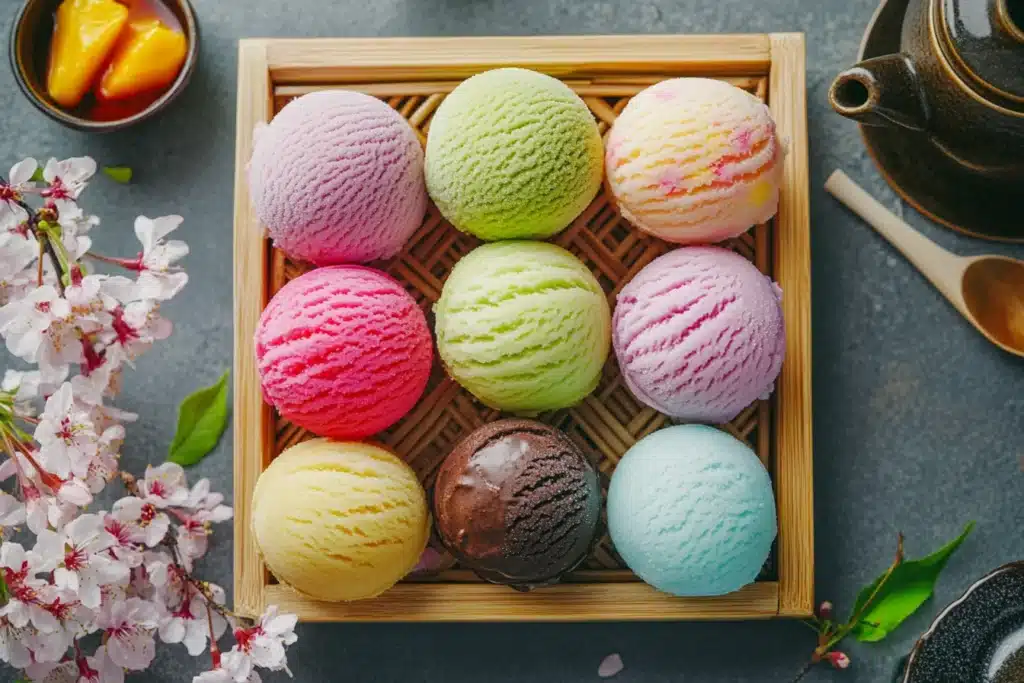Imagine unwrapping a soft, pillowy Japanese rice cake. It melts in your mouth, revealing creamy ice cream inside. This is the magic of mochi ice cream, a mix of traditional Japanese cuisine and modern dessert.
Your taste buds are about to explore a world of flavors. This world combines the chewy texture of mochi with the cool smoothness of ice cream.
The Japanese rice cake with ice cream is more than a dessert. It’s a cultural experience that brings an old tradition into today’s treats. Food lovers around the world enjoy mochi ice cream for its unique texture and taste.
Key Takeaways
- Mochi ice cream blends traditional Japanese culinary techniques with modern dessert innovation
- The treat offers a unique combination of chewy rice cake and creamy ice cream
- Originated from centuries-old Japanese rice cake traditions
- Available in a wide range of classic and creative flavors
- Represents a fusion of cultural heritage and contemporary cuisine
The Cultural Significance of Mochi in Japanese Cuisine
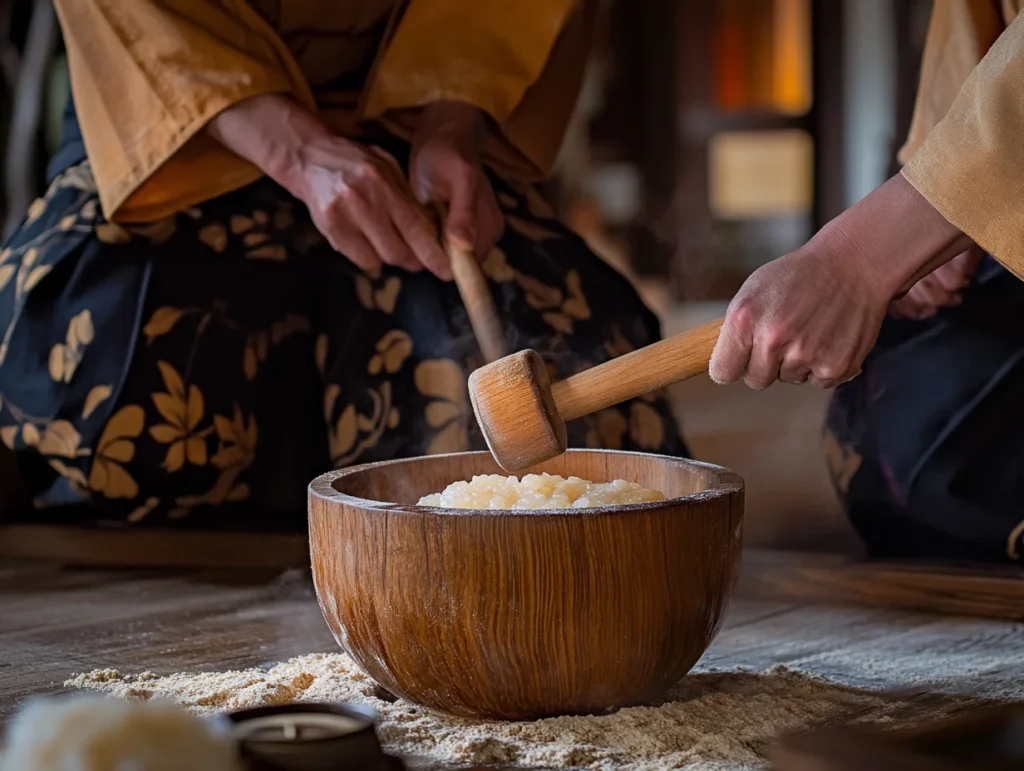
Mochi is more than a simple Japanese rice cake. It has deep roots in Japanese culture, dating back to the Jomon period. This journey into mochi reveals a rich culinary heritage that connects generations through a single treat.
Mochi is a key part of Japanese cuisine, with traditions evolving over centuries. Its preparation and consumption are tied to cultural celebrations and seasonal rituals.
Ancient Origins and Traditional Celebrations
Mochi’s historical significance shines during major Japanese festivals. During Shogatsu, families make Kagami Mochi, a symbolic rice cake arrangement. This tradition started in the Heian period, when samurai classes first adopted these practices.
- Kagami Mochi placed on family altars on December 28
- Symbolizes good luck and prosperity
- Represents a connection to ancestral traditions
Modern Evolution of Mochi
The mochi recipe has changed a lot in recent years. It now includes modern treats like mochi ice cream. Mikawaya, a Los Angeles bakery, was the first to make mochi ice cream in the early 1990s.
Regional Variations Across Japan
Japan has many mochi variations, each with its own flavors and traditions. For example, Sakuramochi is a spring treat with pink rice cake and salted cherry blossom leaves. Kashiwa-mochi is a special Children’s Day treat with white mochi and sweet red bean paste.
- Sakuramochi: Spring celebration dessert
- Kashiwa-mochi: Children’s Day specialty
- Hishi-mochi: Colorful Girls’ Day dessert
Essential Ingredients for Perfect Mochi Ice Cream
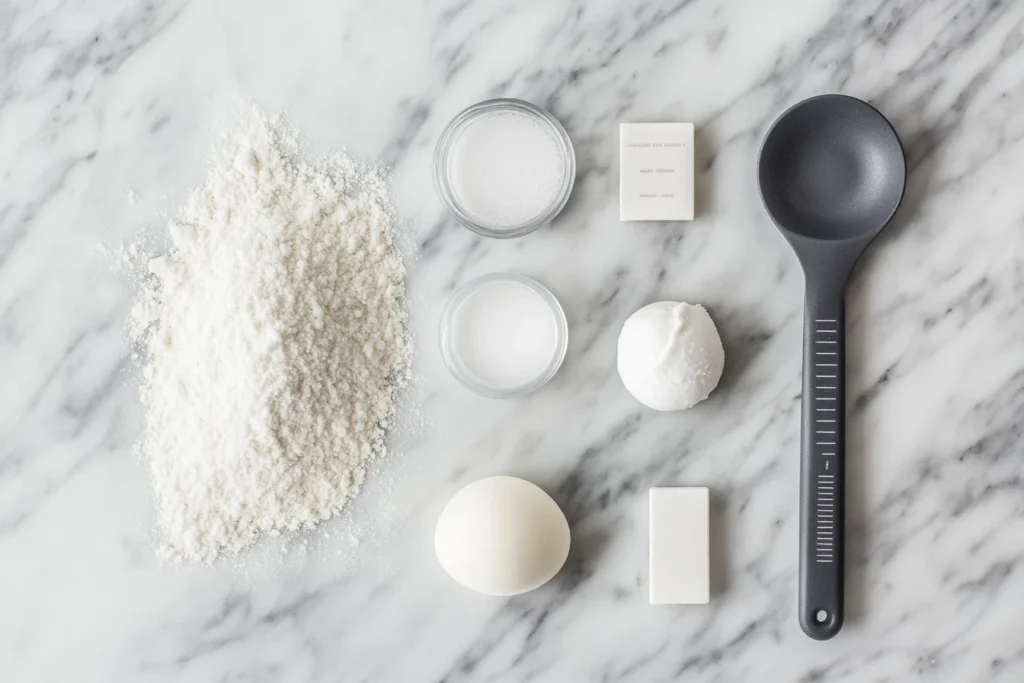
Making delicious mochi ice cream starts with the right ingredients. Your recipe needs precision and quality to get that perfect texture and taste. Let’s look at the key elements for making mochi that will wow your friends and family.
For your mochi-making journey, you’ll need these essential ingredients:
- Sweet rice flour (mochiko) – 1 cup (5½ oz / 160 g)
- Granulated sugar – ¼ cup (2 oz / 57 g)
- Water – 1 cup (8 oz / 225 ml)
- Vanilla ice cream – 1½ cups (8 oz / 225 g)
- Cornstarch for dusting
- Optional: Food coloring (a few drops)
Choosing the right ingredients is key for your mochi ice cream. Sweet rice flour is a must – regular rice flour won’t work. It gives mochi its chewy texture.
| Ingredient | Quantity | Purpose |
|---|---|---|
| Sweet Rice Flour | 1 cup | Creates chewy texture |
| Granulated Sugar | ¼ cup | Adds sweetness |
| Water | 1 cup | Binds ingredients |
| Vanilla Ice Cream | 1½ cups | Filling for mochi |
Pro tip: Prepare your ice cream scoops in advance. Make them into small balls (about 2 tablespoons each) and freeze them solid. This makes wrapping easier when you’re learning to make mochi.
Remember, patience is key. Your mochi needs about 30 minutes in the fridge and at least 2 hours in the freezer to get the perfect consistency. With these ingredients and practice, you’ll become a pro at making homemade mochi ice cream!
Japanese Rice Cake with Ice Cream: A Modern Fusion Dessert
Explore the world of mochi ice cream, a mix of Japanese rice cake and creamy ice cream. This dessert has won the hearts of many, with its perfect mix of texture and taste.
The Birth of Mochi Ice Cream
The story of mochi ice cream started with a mix of old Japanese cooking and new dessert ideas. It began in the late 20th century and quickly became loved around the world. It combines the chewy mochi with the smooth ice cream.
Popular Flavor Combinations
Mochi ice cream comes in many flavors that excite your taste buds:
- Green Tea (Matcha)
- Strawberry
- Chocolate
- Vanilla Bean
- Mango
Texture and Taste Profile
Mochi ice cream is special because of its unique feel. The soft rice cake wraps around a cool ice cream center. It’s a mix that surprises and pleases with every bite.
Food lovers love the rice cake’s delicate wrapping. It keeps the ice cream fresh and adds a special texture. This makes mochi ice cream a fun, modern twist on a classic dessert.
Traditional Mochi Making Process: Mochitsuki
Mochitsuki is a beloved Japanese cooking tradition. It turns glutinous rice into a tasty treat. This tradition brings families together through a special cooking process.
To start making mochi, you need two main things: water and mochigome, a special sticky rice. This process is traditionally done from December 25 to 28. It’s a time for community and celebration.
Key Steps in Mochitsuki
- Soak glutinous rice overnight
- Steam the rice until soft
- Pound the rice in a wooden mortar called usu
- Use a large wooden mallet named kine for rhythmic pounding
- Knead the mixture to achieve perfect texture
The pounding step is key in making mochi. Two people work together. One pounds the rice, and the other turns and shapes it. This teamwork introduces air, making the mochi soft and chewy.
| Traditional Method | Modern Approach |
|---|---|
| Manual rice pounding | Glutinous rice flour |
| Communal activity | Individual preparation |
| Time-intensive process | Quick and convenient |
Traditional mochi making is hard work. But, modern methods with pre-made rice flour make it easier. The goal is to create a stretchy rice cake that shows Japanese cooking skill.
Step-by-Step Guide to Making Mochi Ice Cream at Home
Making mochi ice cream is a fun adventure that mixes old Japanese ways with new dessert ideas. This guide will show you how to make tasty mochi ice cream in your kitchen.
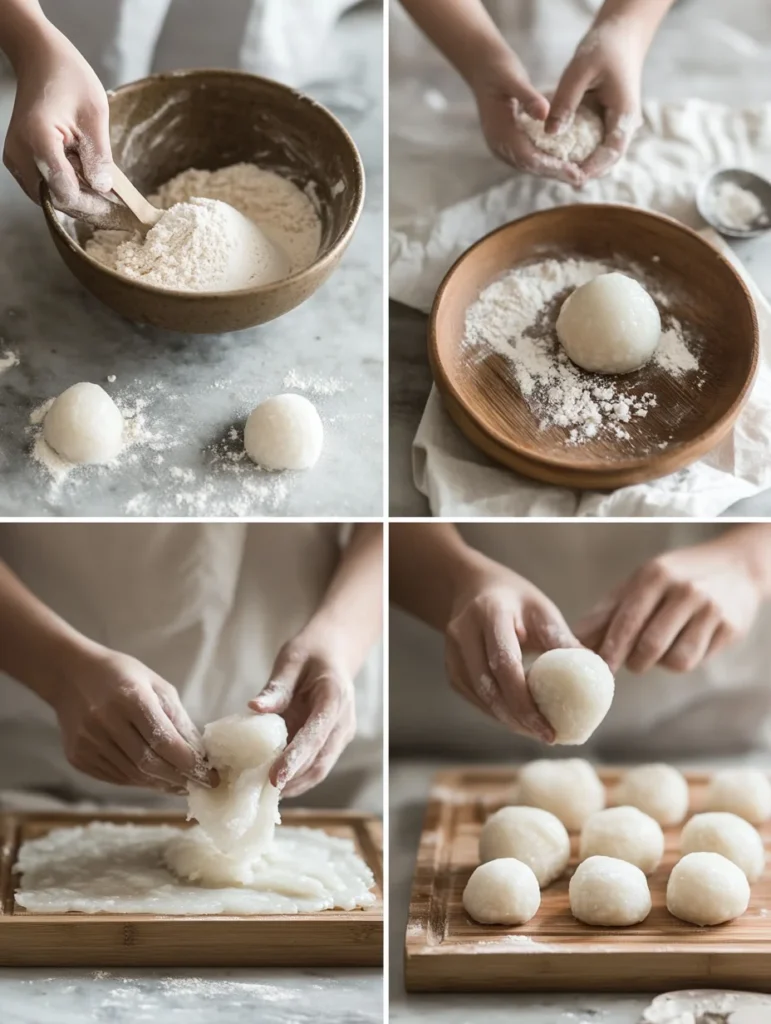
First, get all the ingredients and tools ready. Making perfect mochi ice cream needs careful prep and handling.
Preparing the Mochi Dough
To start, you’ll need these ingredients:
- 100 grams glutinous rice flour
- 50 grams white sugar
- 170 ml water
- 30 grams potato flour
Mix and cook the dough carefully. Steam it for about 30 minutes to get a smooth texture.
Ice Cream Filling Techniques
When making mochi ice cream, be precise. Freeze small ice cream balls (1.6 inches in diameter) for at least 2 hours before wrapping.
| Step | Details |
|---|---|
| Ice Cream Preparation | Scoop 1.5 tablespoon balls, freeze for 8 hours |
| Mochi Thickness | Roll dough to at least 1/4 inch thick |
| Wrapping Time | Work quickly to prevent melting |
Storage and Serving Tips
Freeze your mochi ice cream for 30 minutes before serving for the best taste. These treats can last up to 3 months in the freezer.
Nutritional highlights per serving include:
- Total Calories: 75 kcal
- Carbohydrates: 17 g
- Protein: 1 g
- Fat: 1 g
Five Signature Mochi Ice Cream Flavors
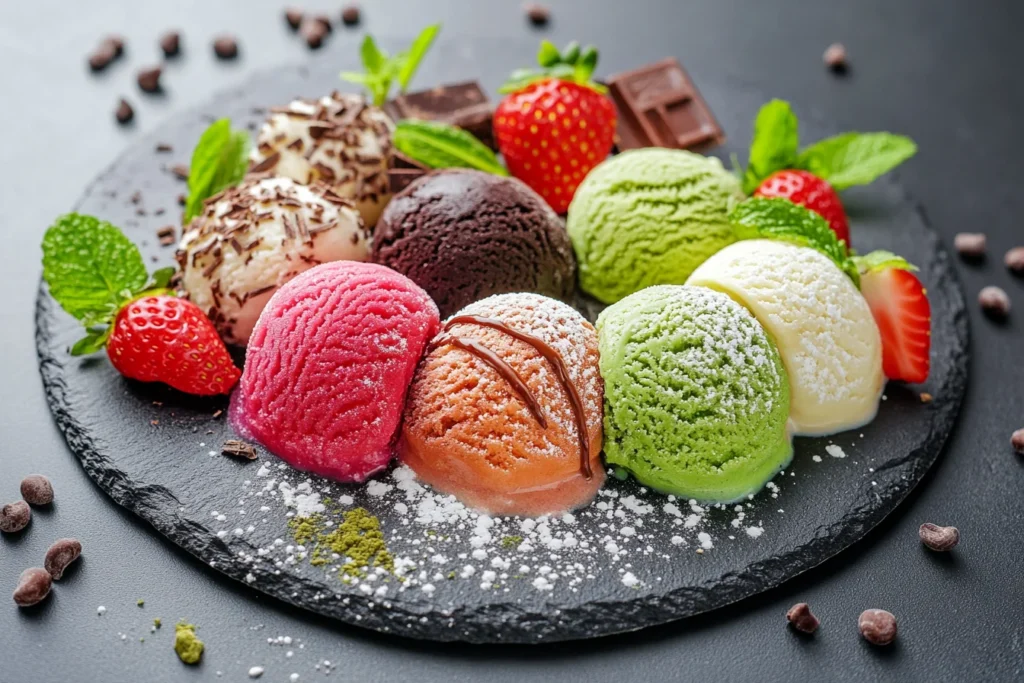
Explore the world of Japanese rice cake with ice cream through these five amazing mochi ice cream recipes. They will excite your taste buds and take you to a place of culinary joy.
Making the perfect mochi ice cream is about finding the right mix of traditional Japanese methods and new flavors. Each flavor gives a special taste experience. It combines creamy ice cream with chewy mochi.
Top Mochi Ice Cream Flavors
- Matcha Green Tea: A classic Japanese flavor with rich, earthy green tea ice cream and soft mochi
- Strawberry: Sweet and fruity, inspired by traditional ichigo daifuku with fresh strawberry notes
- Chocolate: Decadent dark chocolate ice cream wrapped in soft mochi dough
- Vanilla Bean: Smooth, traditional flavor with authentic Madagascar vanilla essence
- Red Bean (Azuki): Traditional Japanese flavor highlighting sweet red bean paste
Start your mochi ice cream journey by learning about the key ingredients and techniques. The secret is making a thin mochi wrapper that holds the ice cream without breaking.
| Flavor | Taste Profile | Cultural Origin |
|---|---|---|
| Matcha | Earthy, slightly bitter | Traditional Japanese |
| Strawberry | Sweet, fruity | Modern fusion |
| Chocolate | Rich, indulgent | Global adaptation |
| Vanilla | Classic, smooth | International favorite |
| Red Bean | Subtly sweet | Traditional Japanese |
Each flavor is a unique culinary journey, mixing traditional Japanese methods with modern dessert ideas. Try these mochi ice cream flavors to make your own tasty frozen treats.
The Art of Wrapping and Shaping Mochi
Learning to wrap and shape mochi is key to making tasty mochi ice cream. It takes precision, patience, and knowing how to make mochi just right.
Exploring both old and new ways to make mochi is important. The right mochi recipe needs careful handling and special techniques for the best results.
Traditional Shaping Techniques
In Japanese cooking, shaping mochi is a fine art. Skilled craftsmen use special methods to make beautiful, even rice cakes:
- Hand-rolling with potato starch to stop sticking
- Applying just the right pressure for smooth surfaces
- Making round shapes with gentle palm movements
Modern Mochi Preparation Methods
New tools have made making mochi easier for home cooks. Today’s mochi making includes:
- Silicone molds for even shapes
- Special mochi makers
- Quick microwave methods
| Technique | Difficulty Level | Time Required |
|---|---|---|
| Traditional Hand Shaping | Advanced | 45-60 minutes |
| Modern Mochi Maker | Beginner | 15-20 minutes |
| Microwave Method | Easy | 10-15 minutes |
Remember, making mochi takes practice. Use short-grain glutinous rice for its chewy, elastic texture.
Pro tip: Dust your surface with potato starch to avoid sticking. The right temperature and method will give you perfect mochi ice cream every time.
Storage and Serving Guidelines for Mochi Ice Cream
Learning how to store your homemade mochi ice cream is key to a great taste experience. It’s important to handle it carefully to keep its special texture and flavor.
Freezer Storage Recommendations
Here are the must-know tips for storing your mochi ice cream:
- Store in an airtight container to prevent freezer burn
- Keep at a consistent freezer temperature of 0°F (-18°C)
- Consume within three months for optimal quality
Serving Tips
To get the best mochi ice cream texture, follow these steps:
Take it out of the freezer and let it soften for 5-10 minutes before serving. This short time lets the rice cake become chewy and delicious.
| Storage Method | Duration | Quality Preservation |
|---|---|---|
| Freezer (Sealed Container) | Up to 3 months | Excellent |
| Refrigerator | 1-2 weeks | Good |
| Room Temperature | 24 hours | Not Recommended |
Pro tip: Wrap individual mochi ice cream pieces in plastic wrap before placing in the container to prevent them from sticking together. Serve on a chilled plate for an extra special presentation of your japanese rice cake with ice cream.
Portion and Nutrition Insights
Each serving of mochi ice cream has about 111 calories. It’s a tasty but moderate treat. The suggested ice cream portion is about 2 tablespoons per mochi.
Health Benefits and Nutritional Information
Your favorite japanese rice cake with ice cream is more than just a tasty treat. It’s also good for you. Mochi, made from glutinous rice, has special benefits that make it a great choice for those who care about their health.
Learning about the nutrition in mochi ice cream helps you make better choices. Here are some important facts:
- Naturally gluten-free base made from sweet glutinous rice
- Rich in complex carbohydrates
- Contains trace amounts of protein
- Low in saturated fats when using lean ice cream fillings
The number of calories in mochi ice cream depends on what’s inside. A typical serving has 100-150 calories. This makes it a good choice for those watching their calorie intake.
To make a healthier mochi recipe, try these tips:
- Use low-fat or Greek yogurt-based ice cream
- Incorporate fruit-based fillings
- Choose smaller portion sizes
- Select dark chocolate or matcha-based variations
Even though mochi is a treat, it’s made from whole grains. This gives it some nutritional benefits. The glutinous rice in mochi provides energy and is less processed than many other desserts.
Common Mistakes to Avoid When Making Mochi Ice Cream
Making perfect mochi ice cream needs focus and practice. Knowing common mistakes helps you make this Japanese treat at home.
Temperature Control Challenges
Temperature is key in your mochi ice cream recipe. Cold ingredients keep the right consistency. Here are important tips for mochi:
- Pre-freeze ice cream scoops in a muffin tray for at least 2 hours
- Maintain freezer temperature around 0°F (-18°C)
- Work quickly to prevent ice cream from melting
Texture Troubleshooting
Getting the right mochi texture is hard. It should feel like pizza dough – smooth and easy to shape.
| Texture Issue | Solution |
|---|---|
| Too Sticky | Add extra cornstarch (¼ cup) |
| Too Dry | Gradually mix in water |
| Uneven Thickness | Use a rolling pin with measured guides |
Wrapping Techniques
Wrapping mochi ice cream needs care. Here are tips for your mochi ice cream recipe:
- Use cornstarch to prevent sticking
- Roll dough thin (approximately 1/8 inch)
- Work on a cool surface
- Wrap quickly to prevent melting
Understanding these challenges helps you make delicious homemade mochi ice cream like a pro.
Conclusion
Your journey into mochi ice cream shows how tradition meets innovation. It started in Japanese cuisine and evolved with Frances Hashimoto’s recipe. Now, it’s a global hit, bringing people together with its unique dessert.
Every bite of mochi ice cream is a story of creativity. You can try classic flavors like green tea or red bean. Or, you can go for something new like strawberry or matcha latte. It’s all about exploring and making your own recipe.
Mochi ice cream is more than just a treat. It’s a symbol of cultural exchange. What was once a favorite among Japanese-Americans is now loved worldwide. It shows how food can bring people and cultures closer.
Your journey with mochi ice cream is just starting. It’s time to get creative and share this amazing dessert. Whether you stick to traditional methods or try new things, the world of mochi ice cream is yours to explore.
FAQ
What is mochi?
Mochi is a traditional Japanese rice cake. It’s made from glutinous rice pounded into a smooth, sticky dough. This treat is used in both sweet and savory dishes, known for its chewy texture.
How is mochi ice cream different from regular ice cream?
Mochi ice cream is a unique dessert. It wraps traditional Japanese mochi dough around a ball of ice cream. This gives a chewy exterior and a creamy interior, unlike regular ice cream.
Is making mochi ice cream difficult for home cooks?
Making mochi ice cream at home is possible with practice. You need to handle the sticky dough and wrap the ice cream without it melting. With patience, you can make delicious homemade mochi ice cream.
What ingredients do I need to make mochi ice cream?
You’ll need glutinous rice flour, water, sugar, cornstarch, and your favorite ice cream. Tools like plastic wrap, a rolling pin, and a freezer are also necessary. High-quality glutinous rice flour is key for the right texture.
Are there gluten-free mochi options?
Traditional mochi is gluten-free because it’s made from glutinous rice flour. But, always check the ingredients and preparation methods, even if you have gluten sensitivities. Many mochi ice cream varieties are gluten-free, making them a good option for those avoiding gluten.
How long can I store homemade mochi ice cream?
Homemade mochi ice cream can last up to two weeks in an airtight container in the freezer. Wrap each piece individually and keep the freezer at a consistent temperature to prevent freezer burn.
What are the most popular mochi ice cream flavors?
Traditional flavors include green tea, red bean, and mango. Modern favorites are strawberry, chocolate, and cookies and cream. Each flavor offers a unique taste experience with the chewy mochi exterior.
Can I make mochi ice cream without special equipment?
Yes, you can make mochi ice cream with basic kitchen tools. While mochi makers can help, a rolling pin, plastic wrap, and careful technique are enough. The key is to work quickly and keep the ingredients cold.

